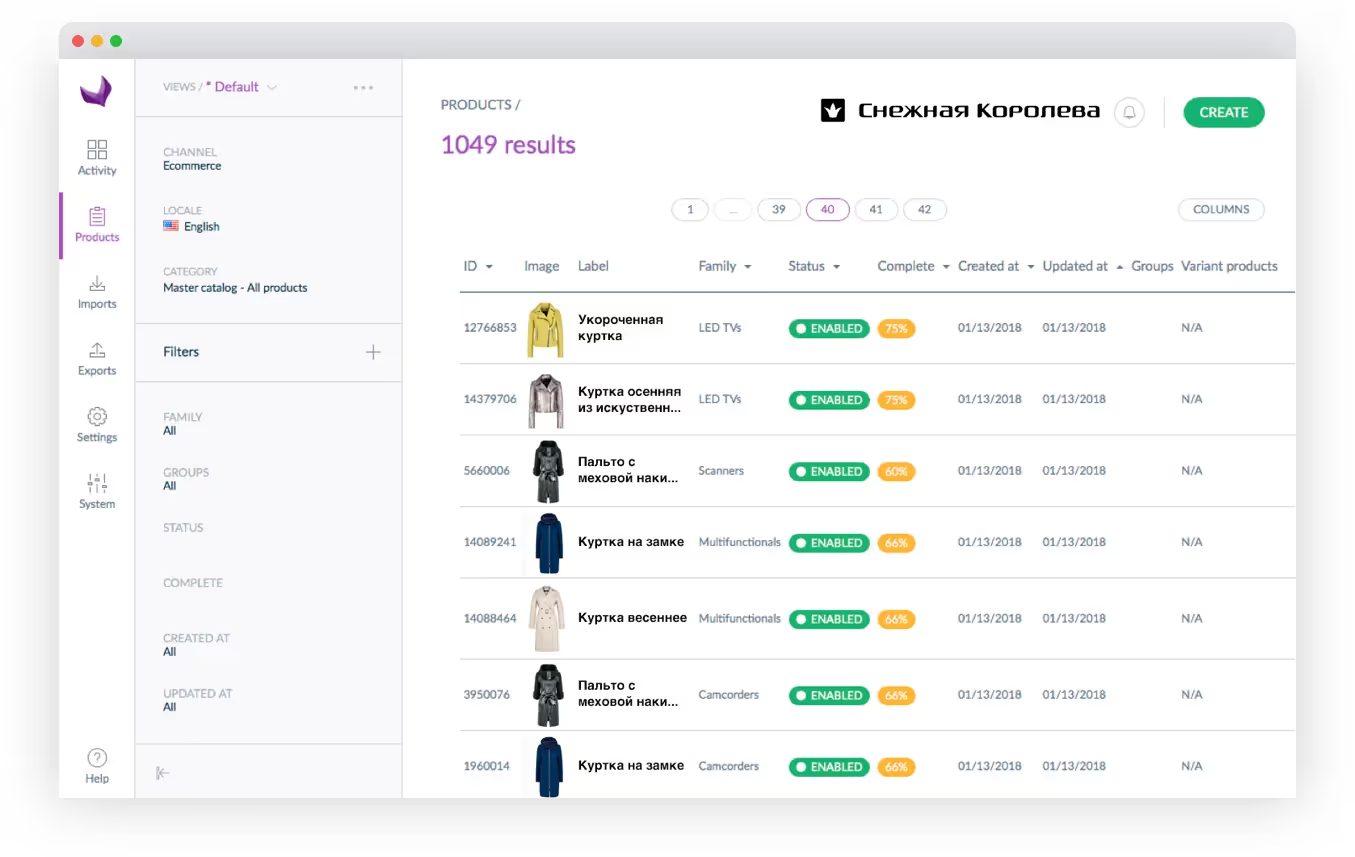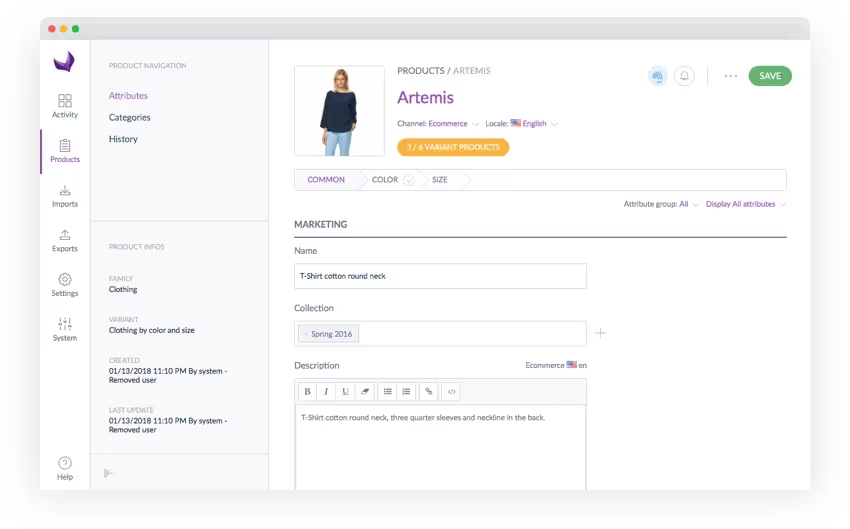Everything Under Control
It often happens that our clients store product information in different sources. For example, they use Excel for manufacturing specifications and plans, SAP — for general product data; high-quality images and certificates are stored in the file storage, and information about the properties required only for the website is posted on the website. This approach is quite chaotic and provokes multiple errors leading to the decrease in conversion rates and sales.
This article will be useful for those who have to manage large amounts of information about products and categories — e-Commerce platforms, delivery services, and omnichannel networks.
CMS systems or SAP complexes are simply not designed for convenient management of such a significant volume of product information. Distributed among distinct and unconnected repositories, the data might get lost or duplicated, not be updated on time, not get into the sales channels or get there with some distortions.
The result is quite predictable. The workflow slows down, time to market for new products increases. It has a negative impact on sales.
One cannot help but recall the famous expression "who owns the information, he owns the world". Or, to be more precise, "who controls the information, he controls the business."
One Product — Dozens of Attributes

There can be up to 200 attributes and characteristics assigned to each item:
- basic information: SKU, barcode, name, description, package contents, etc.;
- placement in the catalogue and product variations: categories and subcategories, performance variants, special marks, etc.;
- technical properties: dimensions, materials, ingredients, warranty obligations, etc.;
- digital information: images, videos, documentation, etc.;
- marketing information: keywords, SEO elements, tags, etc.;
- sales data: prices, user reviews, recommendations and reviews, etc.;
- development and use features: designer notes, style recommendations, assembly instructions, etc.;
- Information specific to sales channels: Amazon titles, categories for Farfetch, mobile app descriptions, and so on;
- localization data: multilingual copies, translations to different languages, etc.;
- Manufacturer details: the manufacturer, production location, supplier, etc.</aside>
All this data is stored in several systems, sometimes in ordinary Excel files (yes, they are still popular even with some big international companies!). Information is duplicated and the sources contradict each other fully or partially*.*
When information is stored in different places, it becomes quite problematic to manage the processes even for one product. Even the slightest catalogue changes provoked by some standard triggers, like adding a new product, changing product information, filling in information by vendors or suppliers, raise doubts. Which fields should be filled in first? Where should the key data be saved? How to make the information filled in by different responsible persons consistent?
Now imagine that you have to manage thousands of articles... The longer a company works in the same mode, the more problems they have.
The Outcomes of Poor Systematization of Product Information
In short, it leads to lower conversion rates, abandoned Shopping Carts, and excessive advertising costs.
Imagine what a huge effort it takes you to change just one parameter! Even a small edit triggers a long process of looking for the necessary repositories, changing data in each relevant repository, comparing and rechecking information.
The challenge is even more complex if you manage a complex product with descriptions in different languages. Employees reach peak levels of Excel knowledge and skills. Nevertheless, this would not make the information management process any less tedious or more transparent.
The load on other systems that are assigned extra functions of product information management increases, thus slowing down their specialized work.

There can be errors in the display of product cards, such as empty fields, misleading descriptions and photos, old prices. As long as customers see it, they just leave. They don't want to make extra efforts and google information elsewhere. Why would they buy headphones without any specifications from you if the information on your competitor's website is more detailed whereas the price difference is negligible?
As the customers don't have access to the necessary information, and orders don't match their expectations, the customer satisfaction level decreases.
Remarketing ads show irrelevant or duplicate products. Here is a real case: once a user checked a plaid shirt on a marketplace. After that, a banner with six absolutely identical shirts in different sizes was "chasing" him for almost a week.
Due to the discrepancies in pricing and the actual SKU content, there will be more abandoned Carts and returned orders. Also, the number of repeat orders will decrease. According to researchers from AT Kearney, companies lose up to 3.5% of their revenue due to poor product information management.
And we suspect it's an underestimation. After all, businesses are not simply losing profit here and now — their overall development is slowing down as well. It complicates the process of entering new markets and discovering new platforms: as the whole process is more resource-consuming than it could be.
PIM System: One System to Rule All Product Information
The solution to many, if not all, problems with contradictory and dispersed product information is the Product Information Management (PIM) master system.
The PIM system collects, stores, and exports product-related information. With the help of a ystem of integrations, it imports and exports text information, media files, analysis data, attributes, regional features, prices, and so on to and from external resources.

You no longer work with lots of dispersed sources and channels, but with a single database and a single interface.
It is easier to control the quality of your data. If you have to specify a data category for CRM, and upload the photo on your website, the PIM system will check the availability of necessary attributes and will not send the product to the channel until everything is correct.
I think you will agree that it is much easier to find, supplement, and correct information in a single PIM system than search it across multiple sources.
One more advantage: other units in the company's information structure no longer have to perform untypical tasks, and the risks at each information change are reduced. Previously, the card editing affected the operation of all or some of the sales channels, but now the changes have no side effects.
PIM is not a silver bullet that will protect a company from any problems with information. It's not an all-in-one solution that integrators would recommend to every single user.
I've picked up six cases where the use of a PIM system is absolutely justified – proved by the international and our customers' experience.
When PIM System is a Must
PIM is not a silver bullet that will protect a company from any problems with information. It's not an all-in-one solution that integrators would recommend to every single user.
I've picked up six cases where the use of a PIM system is absolutely justified – proved by the international and our customers' experience.
1. There are 5000+ SKUs in Your Catalogue

t's almost impossible to monitor the quality of information when you have to deal with thousands of products using some conventional tools, as it would take a major part of your human and information resources. The PIM system collects all available data in a single database and displays it in a structured and clear way: you can see if the cards are completed or not or if there is missing or incorrect information.
2. Regular Catalogue Updates

The updates are made to the composition, the number of items in a stock unit — and, consequently, to its description. Information is updated on time and by all the sales channels. The PIM system allows you to perform a single data edit and then upload edited data to the external systems with a couple of clicks. Some PIM systems allow the configuration of rules for automatic updates at fixed time intervals.
By the way, we have a good case for that: a major retailer that changes the stock units' composition every two weeks. Before the PIM system implementation, they used to have regular problems with the outdated information as they simply had no time for regular and timely updates. Incorrect descriptions, misleading images, and irrelevant attributes were a major source of customers' frustration. Due to the PIM system, now the catalog is updated on time and customers get what they expect.
3. You Have Seasonal Products and Categories

At the beginning of each season you have to manually rearrange the catalog and disable / enable separate product cards. The PIM system creates rules for the automatic management of seasonal products: they can be disabled in a couple of clicks. For example, you can make some products available only within a specified time period: for example, watermelons can only be purchased within a period from July to October, and the Christmas toys — from November 1st to January 1st.
4. You Work with Multiple Regions and / or Sales Channels

All channels require their own description, language, currency, analysis, and remarketing data.
This is exactly the case with Tarkett: the company sells floor coatings and sports flooring in more than 100 countries via 30 websites. Each website should be developed with regard to specific legal requirements and particularities of the local market and audience. Meanwhile, 15% of the catalogue (which is almost 30 thousand items!) is renewed every year as products leave or enter the market all the time.
Before the Akeneo PIM system implementation, the information was stored in several sources: ERP (SAP), CSV files of the marketing team, suppliers, and DAM — and was transmitted to 30 websites, printed catalogs, Tarkett partners and representatives. Apart from collecting all information in a single database, the Akeneo PIM master system allowed taking into account the distinct features of each market for card generation.
5. You Have a Marketplace

You have a need for an MDM or a PIM system, which would process data by all sources, combine duplicates, and create a unique structure for cards and product attributes. You can set rules for product cards encouraging suppliers to fill them in.
6. Data Entries in a ProductCard are Made by Different Departments or Employees

PIM systems allow you to assign different access levels to card editing and save the history of changes. Head of a department can see the history of changes at any moment, approve them, comment on them, and send them for revision or roll back to any previous version.
Going back to Tarkett, which I've previously mentioned, their product information is managed by 60 people that live in different regions of the world. The PIM system records the changes suggested by each of them, allowing the administrator to control all existing and previous versions, regardless of their language and sales channel.
One important thing: you can come across lots of PIM systems each having its own features. For example, kt.team integrates Akeneo PIM and Pimcore systems in its projects. The former is a "classic" PIM system, whereas the Pimcore system is not just a master system for product information management: it provides the opportunity of managing client's data, the web content, CMS and other components.
PIM System Implementation Results

The first thing that your employees would notice even if they are not IT experts is a simple interface for product information management. Data entry statistics is available, the problematic fields are visible, descriptions are provided in several languages and for different sales channels, it is possible to sort out categories, hide and open separate products or categories.
After a while, you'll see even more positive consequences of the implementation:
- less errors and contradictions in product cards;
- reduced time to market for new or seasonal products;
- better management of resources (human, timing, technical) for information entry, change and coordination;
- easier and faster content optimization for different sales channels;
- more rapid and effective remarketing campaigns;
- increasing customer satisfaction and loyalty.</aside>
The research suggests that the PIM implementation helps reduce the time to market by 400%, reach the sales growth by 50%, and reduce the returns by 23%. Of course, these are the most prominent results in the global practice and there is no guarantee that you will be able to achieve them.
However, the results of separate cases are also quite indicative.
For example, the headphones manufacturer Skullcandy increased the checkout conversion rate by 15% six months after the PIM system implementation. The brand's small team has no problem controlling the information on four websites (in three languages and with three different currencies) — and they still have enough time for the Skullcandy further development and growth.
Our experience reflects and testifies the international practice: we've implemented PIM systems in the infrastructure of large and medium-sized companies, and each time there was an increase in the conversion rates.
Of course, it is impossible to describe all PIM system features in just one article. Anyways, you're welcome to ask questions about the functionality and our consultants will comtact you.








